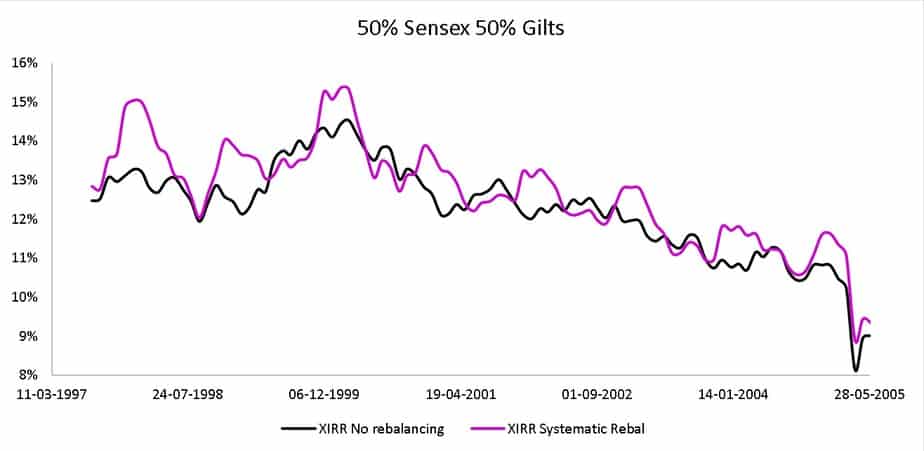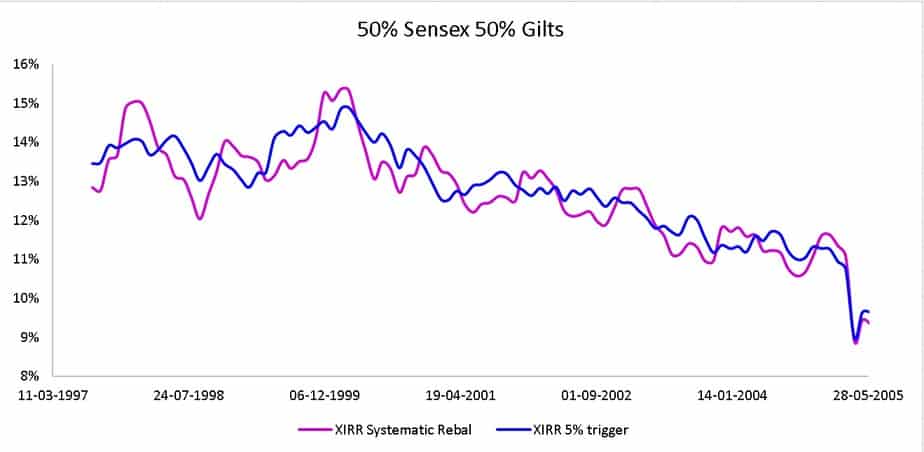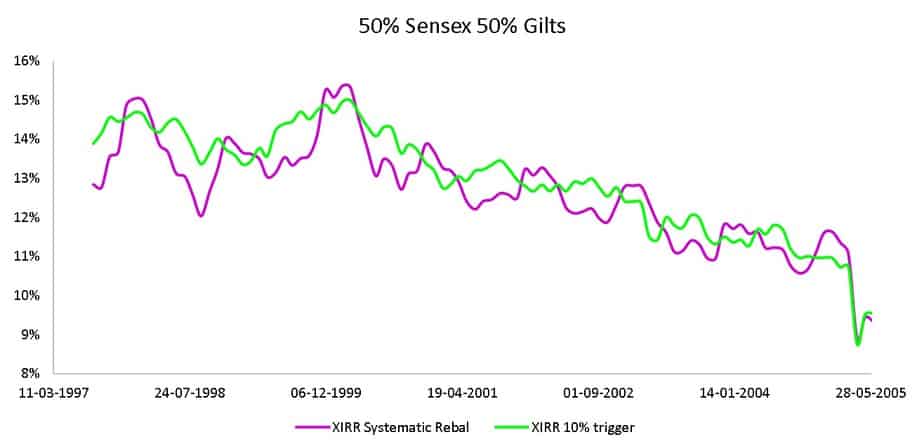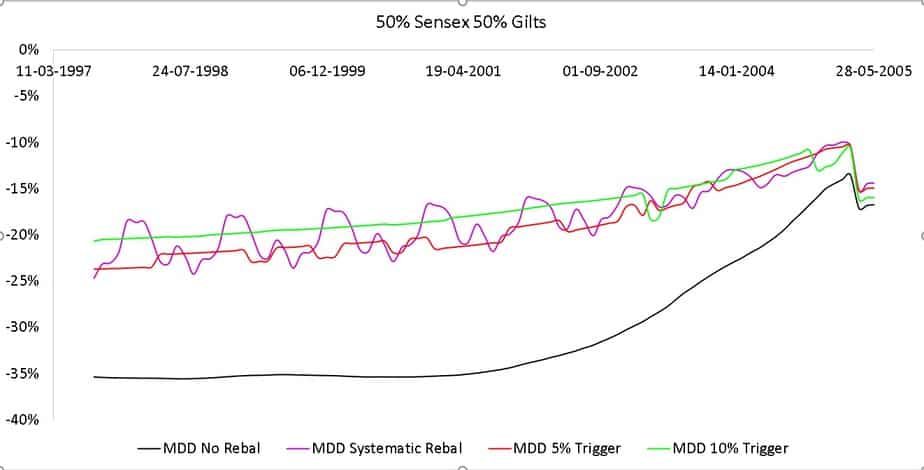Last Updated on December 29, 2021 at 5:35 pm
We discuss the basics of portfolio rebalancing: why do it, how to do it and when to do it, to address some of the common questions that investors have.
What does it mean to rebalance a portfolio? On the face of it, portfolio rebalancing seems like a simple enough, though ignored activity. you start with 50% equity and 50% fixed income, after a year, you find the allocation to 57% equity and 43% fixed income. So you remove 7% equity and buy fixed income with it or vice versa. We shall refer to this annual activity as systematic rebalancing. Also see: The What, Why, How and When of Portfolio Rebalancing With Calculators to Boot
Is rebalancing necessary? If you wish to invest with a plan in mind then yes. Rebalancing reduces portfolio risk, makes us sleep better at night and ensures gains from a well-performing asset is removed (before it is too late) and invited in an asset that is “down” or calmer (like say a liquid fund).
Join 32,000+ readers and get free money management solutions delivered to your inbox! Subscribe to get posts via email! (Link takes you to our email sign-up form)
🔥Want to create a complete financial plan? Learn goal-based investing? Exclusive access to our DIY tools? Increase your income with your skills? Use this link to enjoy massive discounts on our robo-advisory tool & courses! 🔥
The primary goal of rebalancing is to reduce risk regardless of taxes and exit loads associated with the asset allocation reset. In a detailed July 2018 backtest the benefits of lower portfolio risk were discussed: Forget tax and exit loads, this is why your portfolio should be rebalanced each year. Also see: Understanding Volatility of Investment Returns with a Portfolio Rebalancing Simulator
Can I rebalance the portfolio by only adjusting investment amounts to avoid taxes? No, not for long. This is a common newbie investor question with not much net worth. So the amount already invested appears comparable to the amount to be invested each month. I do hope you want the situation to change and the amount invested to grow a lot bigger so that actual rebalance is necessary!
How should I rebalance my portfolio? Suppose you started investing Rs. 1000 a month in a Sensex index fund and Rs. 1000 a month in a gilt mutual fund. Your asset allocation is 50:50. After a year, the equity allocation is Rs. 9000 and the gilt allocation is Rs. 12,500.
The equity allocation is now 42%. So the task of rebalancing is to increase it to 50%. So 50% of (9000+ 12500) = Rs, 10,750. This means Rs. 1250 must be redeemed from the gilt fund and invested in the Sensex index fund.
Should I also rebalance within an asset class? Yes. If you hold large cap and mid cap stocks, for example, a similar rebalancing should be done to manage risk. The simplest would be to combine both inter-asset and intra-asset rebalancing.
I have multiple equity funds. Which should I use for rebalancing? This is the root cause of all confusion associated with rebalancing. If your equity allocation has increased from say 50% to 60%, then you need to remove 10%. The question is where from?
If most of the gains are from large caps (as was the case prior to the crash), then you can reduce some large cap exposure, push it to debt, look at the remaining equity portfolio and then make further adjustments as necessary – shift a little more from large cap to mid/small caps or leave it as is.
Investors need to recognise that “solved examples” will not help much as there are too many possibilities, each year is different and they need to develop the courage to stick to a plan and rebalance without fear.
When should I rebalance my portfolio? To answer the titular question, let us consider the options:
- (A) we can choose to never rebalance
- (B) rebalance once a year (aka systematic rebalancing)
- (C) rebalance if the portfolio deviates by 5% from the asset allocation (Akka 5% trigger rebalancing). For a 50% equity 50% debt portfolio, this means, the rebalance is done only if equity is higher than 55% or lower than 45%.
- (D) rebalance if the portfolio deviates by 10% from the asset allocation (Akka 10% trigger rebalancing)
- (E) Rebalance tactically. For instance see: This “buy high, sell low” market timing strategy surprisingly works!
We shall only consider options A to D in this study. Option (E) will also work but requires higher levels of discipline and is not for everyone. We shall consider three different portfolios: with 50% equity, 60% equity and 70% equity.
The backtest is done with Sensex and I-bex gilt index and 95 15-year rolling durations from Aug 1997- Aug 2013 to June 2005-June-2020. In each of the graph shown below, there are 95 data points in each line.
Please keep in mind: we are looking at a static asset allocation over 15-years. Goal-based reduction in equity exposure as the goal approaches are not considered in this study. To understand how to handle this crucial step, see: lectures on goal-based portfolio management
Rebalancing a 50% equity 50% debt portfolio
Amusingly, the systematically rebalanced portfolio beats the un-rebalanced one 69% of the backrests. Amusing because that was not the intention!

The 5% trigger rebalancing always beats the unbalanced portfolio and sometimes does better than systematic rebalancing.

The 10% trigger also does just as well. Both 5% and 10% triggers do better than systematic rebalancing about 60% of the 95 runs.

XIRR (% of runs the method worked better than the un-rebalanced portfolio)
- systematic: 69%
- 5% trigger: 100%%
- 10% trigger: 98%
Shown next is the maximum drawdown. That is the maximum the portfolio fell from a peak in its 15-year year journey. If this does not convince you to rebalance regularly, nothing else will.

Next, we consider the maximum no of continuous months underwater. This means how long the portfolio was continuously below a peak. The higher this number, the higher the risk.
- Unbalanced: 20 months (typically = median and mode)
- systematic: 15-16 months
- 5% trigger: 16 months
- 10% trigger: 15 months.
Next is the portfolio ups and down month after the month measured via the standard deviation. Higher this value, more the volatility
- Unbalanced: 17%
- systematic: 14%
- 5% trigger: 14%
- 10% trigger: 14%
Finally comes the metric that chooses the winner. We have ignored taxes and exit loads. So the method that results in minimum rebalancing events minimises these costs.
No of rebalancing events
- Unbalanced: not applicable
- systematic: 15 times
- 5% trigger: 19-20 (typically = median and mode)
- 10% trigger: 5-6
Winner for 50% equity 50% debt portfolio: 10% trigger rebalancing. This much deviation can be tolerated because of the “balance” in the portfolio.
See: Will Benjamin Graham’s 50% Stocks 50% Bonds strategy work for India?
Rebalancing a 60% equity 40% debt portfolio
XIRR (% of runs the method worked better than the un-rebalanced portfolio)
- systematic: 71%
- 5% trigger: 14%
- 10% trigger: 33%
The trigger methods work better than the systematic method only 1% (5% trigger) and 18% (10% trigger) of the runs.
Maximum no of continuous months underwater
- Unbalanced: 20-22 (typically = median and mode)
- systematic: 16-17
- 5% trigger: 16-18
- 10% trigger: 16-18
Volatility
- Unbalanced: 19%
- systematic: 16%
- 5% trigger: 15%
- 10% trigger: 15%
No of rebalancing events
- Unbalanced: not applicable
- systematic: 15 times
- 5% trigger: 5 (typically = median and mode)
- 10% trigger: 2
Winner for 60% equity 40% debt portfolio: systematic rebalancing. It performs better and is emotionally easier to handle.
Rebalancing a 70% equity 30% debt portfolio
XIRR (% of runs the method worked better than the un-rebalanced portfolio)
- systematic: 73%
- 5% trigger: 19%
- 10% trigger: 38%
The trigger methods work better than the systematic method only 31% (10% trigger) of the runs and never (5% trigger).
Maximum no of continuous months underwater
- Unbalanced: 22-23 (typically = median and mode)
- systematic: 19-20
- 5% trigger: 18-20
- 10% trigger: 20
Volatility
- Unbalanced: 21%
- systematic: 19%
- 5% trigger: 17%
- 10% trigger: 18%
No of rebalancing events
- Unbalanced: not applicable
- systematic: 15 times
- 5% trigger: 4-5 (typically = median and mode)
- 10% trigger: 2
Winner for 70% equity 30% debt portfolio: systematic rebalancing. It performs better and is emotionally easier to handle.
To summarise, rebalancing is essential to reduce portfolio risk.In the set of limited backrests performed in this study, rebalancing actually manages to outperform (higher returns) a un-rebalanced portfolio. Though that should not be the motive to rebalance. For 50% equity, a trigger of up to 10% deviation works well but for higher allocations, systematic annual rebalancing does the job.

Use our Robo-advisory Tool to create a complete financial plan! ⇐More than 3,000 investors and advisors use this! Use the discount code: robo25 for a 20% discount. Plan your retirement (early, normal, before, and after), as well as non-recurring financial goals (such as child education) and recurring financial goals (like holidays and appliance purchases). The tool would help anyone aged 18 to 80 plan for their retirement, as well as six other non-recurring financial goals and four recurring financial goals, with a detailed cash flow summary.
🔥You can also avail massive discounts on our courses and the freefincal investor circle! 🔥& join our community of 8000+ users!
Track your mutual funds and stock investments with this Google Sheet!
We also publish monthly equity mutual funds, debt and hybrid mutual funds, index funds, and ETF screeners, as well as momentum and low-volatility stock screeners.
You can follow our articles on Google News

We have over 1,000 videos on YouTube!

Join our WhatsApp Channel



- Do you have a comment about the above article? Reach out to us on Twitter: @freefincal or @pattufreefincal
- Have a question? Subscribe to our newsletter using the form below.
- Hit 'reply' to any email from us! We do not offer personalised investment advice. We can write a detailed article without mentioning your name if you have a generic question.
Join 32,000+ readers and get free money management solutions delivered to your inbox! Subscribe to get posts via email! (Link takes you to our email sign-up form)
About The Author
 Dr M. Pattabiraman (PhD) is the founder, managing editor and primary author of freefincal. He is an associate professor at the Indian Institute of Technology, Madras. He has over 13 years of experience publishing news analysis, research and financial product development. Connect with him via Twitter(X), LinkedIn, or YouTube. Pattabiraman has co-authored three print books: (1) You can be rich too with goal-based investing (CNBC TV18) for DIY investors. (2) Gamechanger for young earners. (3) Chinchu Gets a Superpower! for kids. He has also written seven other free e-books on various money management topics. He is a patron and co-founder of “Fee-only India,” an organisation promoting unbiased, commission-free, AUM-independent investment advice.
Dr M. Pattabiraman (PhD) is the founder, managing editor and primary author of freefincal. He is an associate professor at the Indian Institute of Technology, Madras. He has over 13 years of experience publishing news analysis, research and financial product development. Connect with him via Twitter(X), LinkedIn, or YouTube. Pattabiraman has co-authored three print books: (1) You can be rich too with goal-based investing (CNBC TV18) for DIY investors. (2) Gamechanger for young earners. (3) Chinchu Gets a Superpower! for kids. He has also written seven other free e-books on various money management topics. He is a patron and co-founder of “Fee-only India,” an organisation promoting unbiased, commission-free, AUM-independent investment advice.Our flagship course! Learn to manage your portfolio like a pro to achieve your goals regardless of market conditions! ⇐ More than 3,500 investors and advisors are part of our exclusive community! Get clarity on how to plan for your goals and achieve the necessary corpus no matter the market condition!! Watch the first lecture for free! One-time payment! No recurring fees! Life-long access to videos! Reduce fear, uncertainty and doubt while investing! Learn how to plan for your goals before and after retirement with confidence.
Increase your income by getting people to pay for your skills! ⇐ More than 800 salaried employees, entrepreneurs and financial advisors are part of our exclusive community! Learn how to get people to pay for your skills! Whether you are a professional or small business owner seeking more clients through online visibility, or a salaried individual looking for a side income or passive income, we will show you how to achieve this by showcasing your skills and building a community that trusts and pays you. (watch 1st lecture for free). One-time payment! No recurring fees! Life-long access to videos!
Our book for kids: “Chinchu Gets a Superpower!” is now available!


Must-read book even for adults! This is something that every parent should teach their kids right from their young age. The importance of money management and decision making based on their wants and needs. Very nicely written in simple terms. - Arun.Buy the book: Chinchu gets a superpower for your child!
How to profit from content writing: Our new ebook is for those interested in getting a side income via content writing. It is available at a 50% discount for Rs. 500 only!
Do you want to check if the market is overvalued or undervalued? Use our market valuation tool (it will work with any index!), or get the Tactical Buy/Sell timing tool!
We publish monthly mutual fund screeners and momentum, low-volatility stock screeners.
About freefincal & its content policy. Freefincal is a News Media organisation dedicated to providing original analysis, reports, reviews and insights on mutual funds, stocks, investing, retirement and personal finance developments. We do so without conflict of interest and bias. Follow us on Google News. Freefincal serves more than three million readers a year (5 million page views) with articles based only on factual information and detailed analysis by its authors. All statements made will be verified with credible and knowledgeable sources before publication. Freefincal does not publish paid articles, promotions, PR, satire or opinions without data. All opinions will be inferences backed by verifiable, reproducible evidence/data. Contact Information: To get in touch, please use our contact form. (Sponsored posts or paid collaborations will not be entertained.)
Connect with us on social media
- Twitter @freefincal
- Subscribe to our YouTube Videos
- Posts feed via Feedburner.
Our publications
You Can Be Rich Too with Goal-Based Investing
 Published by CNBC TV18, this book is designed to help you ask the right questions and find the correct answers. Additionally, it comes with nine online calculators, allowing you to create custom solutions tailored to your lifestyle. Get it now.
Published by CNBC TV18, this book is designed to help you ask the right questions and find the correct answers. Additionally, it comes with nine online calculators, allowing you to create custom solutions tailored to your lifestyle. Get it now.Gamechanger: Forget Startups, Join Corporate & Still Live the Rich Life You Want
 This book is designed for young earners to get their basics right from the start! It will also help you travel to exotic places at a low cost! Get it or gift it to a young earner.
This book is designed for young earners to get their basics right from the start! It will also help you travel to exotic places at a low cost! Get it or gift it to a young earner.Your Ultimate Guide to Travel
 This is an in-depth exploration of vacation planning, including finding affordable flights, budget accommodations, and practical travel tips. It also examines the benefits of travelling slowly, both financially and psychologically, with links to relevant web pages and guidance at every step. Get the PDF for Rs 300 (instant download)
This is an in-depth exploration of vacation planning, including finding affordable flights, budget accommodations, and practical travel tips. It also examines the benefits of travelling slowly, both financially and psychologically, with links to relevant web pages and guidance at every step. Get the PDF for Rs 300 (instant download)